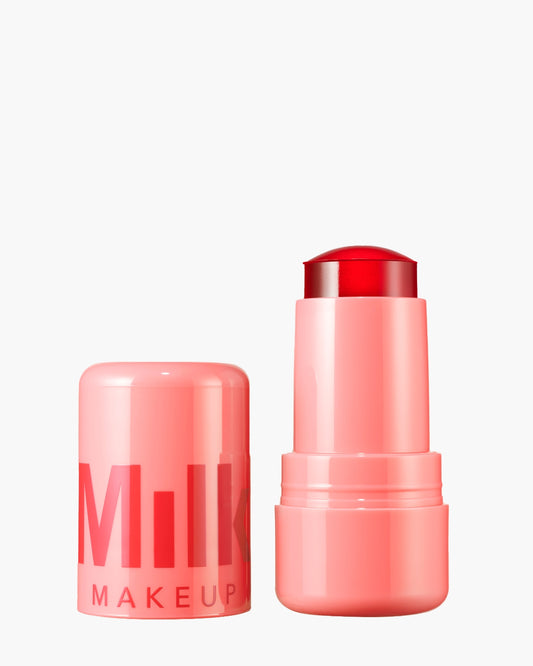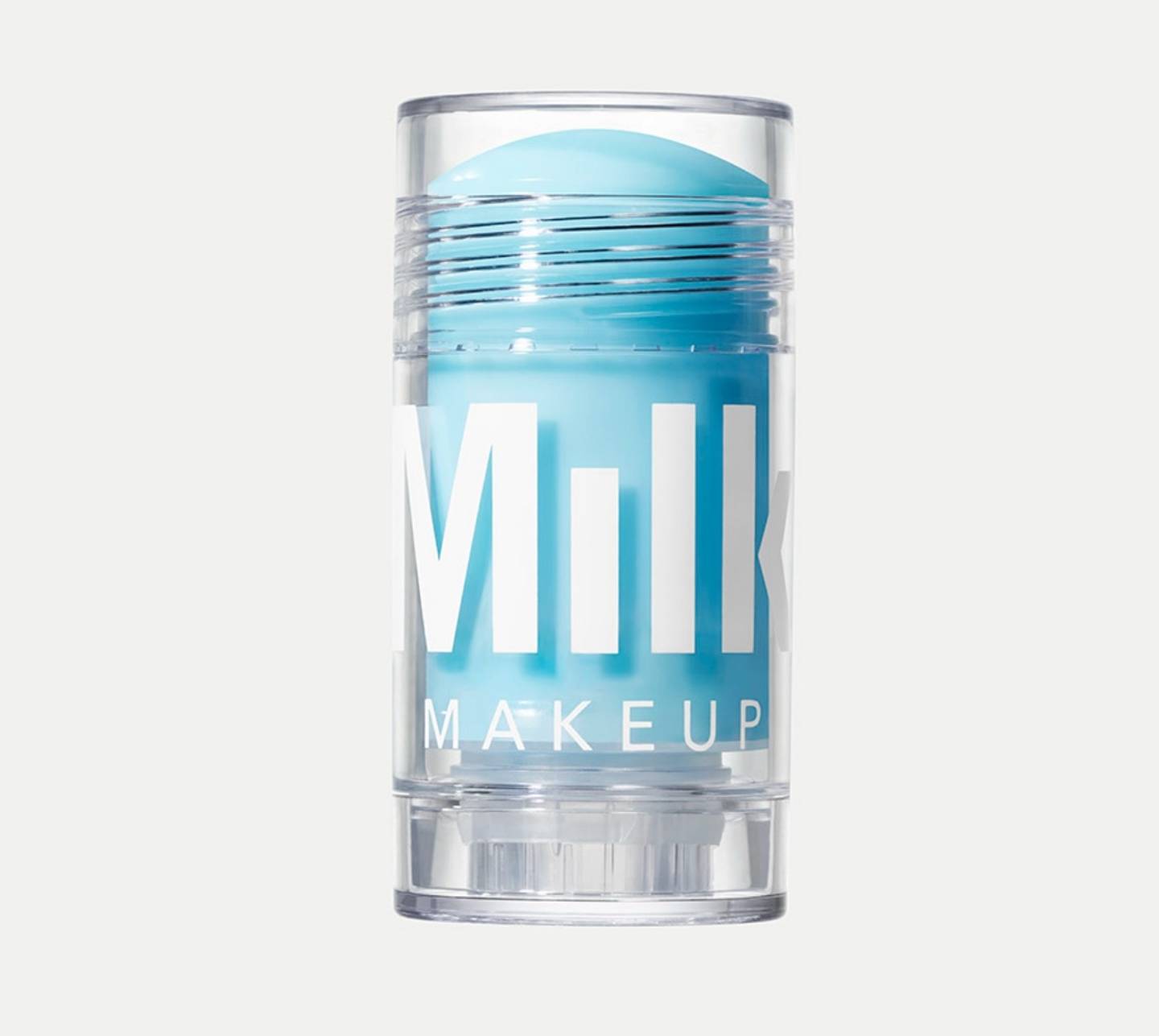Whichever culprit is to blame, there are some mornings when you inevitably wake up wondering how to depuff your face. If you don’t have an on-call esthetician, it’s up to your skincare products to deliver the quick refresh that you need. But which topical methods actually work when you’re running on too little sleep or too much salt?
At Milk HQ, our team swears by our Cooling Water Under Eye Gel Stick as the ideal invigorating treatment. This solid gel stick acts like a shot of espresso for your face to help it feel fresh and look less puffy. The twist-up applicator lets you glide it on seamlessly even if you’re on-the-go, or in the middle of an especially rushed morning. We designed it for targeted use on your under eyes, but it also doubles as an allover treatment wherever you need it. The formula contains soothing seawater for hydrated, awakened skin, plus a shot of energizing caffeine.
Read on to find out exactly how it works—and get some derm-approved tips that ensure that you’ll never have a puffy day again.
Why does my face look puffy?According to dermatologists, a bloated face or puffy under eyes can stem from a number of factors, which all cause excess fluid in your face. “Puffiness in the morning often results from fluid retention,” says dermatologist Marisa Garshick, M.D. “Fluid retention can occur as a result of too little sleep or from high salt intake.” You might notice that certain areas of your face seem more prone to puffiness than others, like your under eyes or cheeks. That’s because fluid tends to build up most in these areas. Along with lack of sleep and high sodium, other factors can include skin irritants or allergies. (If that’s the case, consult a derm or doctor first.) If your facial puffiness seems more noticeable after nights where you haven’t gotten your recommended eight hours or have had too many salty snacks, decrease fluid buildup by eating lower-sodium foods at night and swapping screen time for sleep time. Which skincare ingredients help a puffy face?When swelling strikes unexpectedly, topical caffeine is your best friend. “When it comes to puffiness, caffeine is your go-to ingredient,” says dermatologist Joshua Zeicher, M.D. According to Dr. Garshick: “It works to constrict the blood vessels, which can help reduce puffiness and swelling.” Even when applied topically, caffeine has been shown to penetrate your skin barrier and speed up microcirculation, giving your skin a bonus healthy glow. If you rely on your morning coffee to wake up, think of skincare with caffeine in the same way: It helps perk your complexion up with a shot of energy. |
 |
While derms usually recommend caffeine as the most effective ingredient for reducing the appearance of puffiness, hydrating ingredients like hyaluronic acid can also help. “If puffiness is a result of excessive dryness leading to inflammation, moisturizing or hydrating ingredients can be a helpful way to address this,” says Dr. Garshik. The natural seawater in our Cooling Water Stick gives it a hydrating finish.
Will rubbing ice on my face help depuff it?
You’ve probably seen influencers and models dunking their faces in bowls of ice water all over Instagram and TikTok. That’s because cooling your skin can help bring down swelling, much like icing an injury. “Cool temperatures help constrict blood vessels and calm inflammation,” says Dr. Zeichner. That doesn’t mean you need to brace yourself for a morning ice bath; there are easier, less extreme ways to deliver a blast of cold to your skin.
Sara Wren, our Director of Artistry, recommends storing your Cooling Water Stick in your fridge to maximize its refreshing effects. “I love to use it right out of the fridge,” she says. Not only will your skin appreciate the extra chill, you won’t need to hold your breath and give yourself a pep talk before you use it.
When your under eyes look especially swollen, try alternating Cooling Water with a clean, cold spoon. “Applying a cold spoon to the undereye area can help to depuff,” says Dr. Garshick. “The cold reduces blood flow to the area, and as a result, reduces overall puffiness.”
How to Do a Depuffing Face Massage With Milk Cooling Water
While Cooling Water is designed for swipe-and-go convenience, you can enhance its effects by pairing it with at-home facial massage. One of our favorite ways to do this is with targeted skincare tools like face rollers or gua sha, both of which can help stimulate lymphatic drainage and boost circulation.
“If you’re puffy, facial massage, rolling devices, or gua sha can all help enhance movement of your lymph system to drain away excess fluid,” says Dr. Zeichner.
Apply a coat of Cooling Water to create a hydrated, smooth surface for your face roller or gua sha to glide over. Sara loves pairing it with our Sunshine Oil to make face rolling even easier. “Since Cooling Water is super gentle, I like to use it alone in circular motions around my eyes,” she says. “Then I apply it to the rest of my face along with a layer of Sunshine Oil and continue to face roll, moving from the center of my face outward to promote circulation.”
Whether you’re recovering from a late night swiping through your FYP or too many drinks at Happy Hour, try these tips to get depuffed, fast. “When I wake up with allergy eyes or a hangover, Cooling Water is literally my life saver,” says Sara.
Meet the Experts
Joshua Zeichner, M.D., F.A.A.D., (he/him) is an Associate Professor of Dermatology and the Director of Cosmetic & Clinical Research in Dermatology at Mount Sinai Hospital in New York City. He is one of the country's key opinion leaders in treating acne and rosacea, and is an expert in cosmeceuticals, skin care, and cosmetic dermatology. As an educator, Dr. Zeichner teaches dermatology residents and regularly lectures to international audiences. His work has been published in the top peer reviewed dermatology journals, and he can be found quoted across national media.
Marisa Garshick, M.D., F.A.A.D., (she/her) is a board-certified dermatologist and an Assistant Clinical Professor of Dermatology at Cornell University in New York. Dr. Garshick has numerous publications in scientific journals and book chapters, including a chapter on the treatment of acne, and has presented at national meetings. She is a member of the American Academy of Dermatology, the American Society of Dermatologic Surgery and the Women’s Dermatologic Society.
Sara Wren (she/her) is the Director of Artistry at Milk Makeup. In her role, she does all the makeup artistry and direction for our Milk Makeup global campaigns, educates the staff and field team on application methods, stars in the brand’s social media videos, and travels to different markets spreading Milk Makeup’s good vibes. When she’s not on set, Sara loves experimenting with DIY hair colors, eating tacos, watching basketball, and scouring for vintage cosmetics to add to her impressive collection.











 "
"

